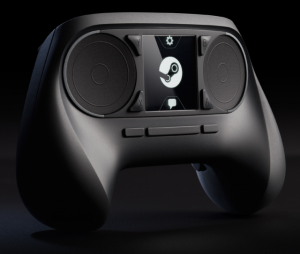 The Steam Controller was recently unveiled as part of the larger set of Steam Machine announcements. The Steam Machine is an open specification for console-like PCs allowing for easy integration of PC games into your living room. While boxes can vary in power and capacity – and so in cost – the Steam Controller is an attempt to normalize the interface.
The Steam Controller was recently unveiled as part of the larger set of Steam Machine announcements. The Steam Machine is an open specification for console-like PCs allowing for easy integration of PC games into your living room. While boxes can vary in power and capacity – and so in cost – the Steam Controller is an attempt to normalize the interface.
The controller represents a significant evolution of what’s become a relatively stagnant controller design. While this is a pre-release design that may change it’s unlikely that the core features will change drastically. It shares the two lobed, split-surface design first popularized by the original PlayStation controller but with significant differences.
The most striking difference is the two large, concave, clickable touchpads that replace the analog sticks, directional pad and button-cross of most controllers. These feature a textured face and haptic feedback that, in theory, allow for fine grain movement without the physical resistance of a mechanical control. Sitting between the pads is a small, color touchscreen that can, obviously, be customized by whatever software you’re playing. Lastly there’s a more traditional, but sizable, collection of physical buttons, triggers and bumpers.
Most console controllers are designed, essentially, with a generic applicability to well-worn genres in mind. Even Nintendo, known for exotic experiments in controller design, has never strayed far from the requirements of the top genres. Controllers are made to support driving, free-roaming adventure, platforming and the ever-present, all-important first person shooter. Specialized controllers exist that are much more suited to certain specific needs, but the main controller needs to be a jack of all trades.
The primary design challenge being set for Steam Controller isn’t to match existing gamepads but rather to replace traditional keyboard/mouse control. This is the key to bringing PC gaming to the living room: a comfortable couch experience. By relying so heavily on touch Valve is creating what may well be the most customizable controller to date. The trackpads can emulate traditional analog controls, mousing, zone-based button mapping and, as has been show in some early demonstrations, can work together to create a larger, virtual mouse surface. Like the “drive-by-wire” controls of newer cars divorcing the mechanics from the experience means that interface can be tuned to provide essentially whatever is required.
I’m optimistic that the controller can meet it’s goal of providing an elegant mouse/keyboard alternative. The touchpads can, I’m sure, tackle whatever mouse-based maneuvers are required and the programmable touch screen and many alternate buttons should be able to map whatever other keyboard controls are needed. My primary fear is that by moving so completely to address that particular challenge Valve has created a controller than won’t be able to compete in the traditional console space. I’m less confident, for example, that touchpads – even ones as advanced as these – can truly rival a physical analog stick. I’m even less confident that they can emulate, with any real sense of accuracy, a directional pad.
The advanced haptics promised may, as is being promised, be the answer to my concerns. In theory they can provide direct, physical feedback through the track pads that mimic, or possibly even surpass, the mechanical resistance provided by traditional sticks and buttons. It’s impossible to know if the controller can succeed in this without seeing it action, but Valve has earned considerable trust.
